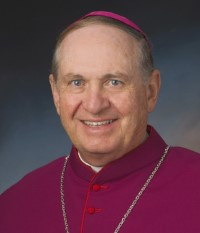In the Heartland With Bishop Pates: Dying and Rising
by Bishop Pates | April 16, 2019

There is a very striking, free standing statue that occupies the sanctuary behind the altar and ambo at St. Ambrose of Woodbury Catholic Church in Woodbury, Minnesota. The statute is titled “The dying and rising Christ.”
The sculptor seeks to capture the paschal mystery, hence the placement of the piece on the altar platform where the very paschal mystery is made present every time the Eucharist is celebrated. “Do this in memory of me.”
What is expressed is that from the seemingly futile death of Jesus on the cross there is also an energy of resurrection, of coming to new life. Recalled is the teaching in the Gospel of John: “Amen, amen I say to you, unless a grain of wheat falls to the ground and dies, it remains just a grain of wheat; but if it dies, it produces much fruit. Whoever loves his life loses it, but whoever hates his life in this world will preserve it for eternal life.” (Jn. 12:24-25).
And so it seems that a similar experience is happening in our Church community as we address the sad history of clerical sexual abuse. As we come forward, identify and take responsibility for this evil, we see that death is occurring and new life is springing forth. We need to firmly attest – this behavior cannot be condoned, it is a sin and a crime and all must be done to extinguish it in the life of the Church. Part of the transformation also involves the prime attention we give to victims – seeking forgiveness, offering opportunities for ongoing support and healing, taming the trauma they have undergone.
And once we make a commitment to transparency and change, new perspectives emerge. For it becomes obvious that regret is empty unless it is accompanied by reform. The first steps to this pathway began in 1988 as the diocese adapted an early policy to counter the sexual abuse of minors by clerics. It has taken hold since the last reported sexual abuse of this kind took place in 1997, 22 years ago.
Reform and stronger policies accelerated in 2002 with the adoption of “The Charter for the Protection of Children and Young People” legislated by the United States Conference of Catholic Bishops. Among the effective policies that were implemented:
1) “One strike and you’re out.” A single substantial claim of sexual abuse of a minor by a church worker results in the exclusion of that individual from church ministry on a permanent basis.
2) All reports of such action are referred immediately to law enforcement for disposition.
3) An Allegation Review Committee, which present constitution in the Diocese of Des Moines is a judge, a chief of police, a lawyer, a counselor, a school teacher, a deacon and a priest who advise the bishop on all matters regarding clerical sexual abuse.
In addition, initiatives have been undertaken to prevent further occurrences:
• 18,000 background checks have been conducted in the Diocese of Des Moines of all church workers;
• 16,000 persons have been involved in safe environment trainings;
• The diocese undergoes an annual audit by a national agency to insure compliance with these policies. Also, our church workers participate in monthly training on the prevention of this and other abuses in a program entitled: “Virtus.”
The identification and implementation of these measures can be painful insofar as it involves difficult revelations and coming to grips with the truth. It is a form of death to old ways.
But what is inevitably experienced simultaneously is the coming to new life, of resurrection.
The very message that is abroad this Sunday, “He is risen. He is risen indeed,” becomes real in our circumstances and highlights the meaning and purpose of living the Christian life. In the aftermath of this extensive trial that has darkened our path, purification is coming about. We are developing an ever clearer focus of the mission entrusted to us as church, as beloved disciples: “To make Jesus Christ known and loved in our time by choosing to live out the Gospel at every moment.”
The message of the sculpture in St. Ambrose of Woodbury Church is not applicable only to the present crisis but an invitation to make our own the “dying and rising of Christ” throughout our entire life experience.